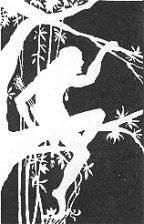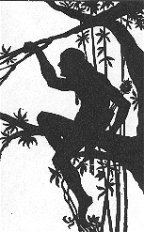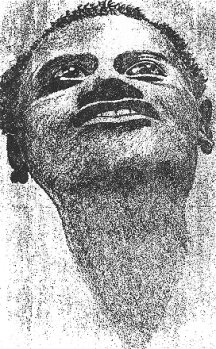
First and Only Online Fanzine Devoted to the Life and Works of Edgar Rice Burroughs Official Edgar Rice Burroughs Tribute Site Since 1996 ~ Over 10,000 Webpages in Archive |

First and Only Online Fanzine Devoted to the Life and Works of Edgar Rice Burroughs Official Edgar Rice Burroughs Tribute Site Since 1996 ~ Over 10,000 Webpages in Archive |
Parts 1-3 of this series appeared in 1998 in The Nubian News, a weekly African-American newspaper published in Trenton, N.J. See "Works Cited" section for full bibliographic details.


Peppered among the numerous rave reviews for Disney's surprise summer hit, "Tarzan," were a handful of laments that the animated feature in question depicted "an Africa without Africans" (Blisard 1998; Beale 1999; Fox 1999; Rainer 1999). Those Disney execs who responded to this charge cited purely "aesthetic" reasons, such as plot development, time constraints, etc.--in a word, the necessity of condensing an extremely complex novel down to its absolutely simplest terms.Okay, I'll buy that. After all, the black characters from the original novel (Edgar Rice Burroughs' Tarzan of the Apes) were not the only casualties of Disney's aesthetic process: Tarzan's human parents hardly appear on screen, so there goes their identity as English nobility, Tarzan's own identity as an English lordling, as well as his boyhood discovery of his father's cabin (not treehouse!), his father's knife (too intense for younger viewers), his father's library (not Jane's), his father's diary (written in French!), and his own baby-fingerprints (which later establish his "true" identity); lost in the shuffle, too, are no less than two bloody shipboard mutinies, several savage scenes of hand-to-hand (and hand-to-claw) combat, Tarzan's self-education in the English language (from his father's books), Kala's death, Jane's romantic involvement with Clayton, Clayton's identity as Tarzan's cousin (and rival for the Greystoke title), Tarzan's friendship with the disabled Lieutenant D'Arnot, Tarzan's journey "out of Africa" in search of Jane, and his ultimate, noble self-sacrifice for her sake. Whew! All that in one novel? You betcha -- and even more of the same in the original sequel (The Return of Tarzan).
With the current boom in direct-to-video (DTV) animation among the major studios, you can be sure that Disney will follow up on the success of "Tarzan--The Animated Feature" (let's call it "Tarzan I") with a DTV sequel of their own (let's call it "Tarzan II"), recounting the further adventures of the Ape-Man in the Disney Universe. As Billboard Magazine recently pointed out, "creating an animated feature for video is much less expensive than creating one for theatrical release" and Disney in particular is eager "to further legitimize the new genre" (Sherber 1998).
Two of Disney's most recent offerings in that "new genre" both attempted to deal with critiques of the original (theatrical-release) animated features that sired them. "Pocahontas II," for instance, addressed the charges of historical inaccuracy against "Pocahontas [ I ]" by recounting the heroine's (quite historical) adventures in London as an emissary to the Court of King James II; while the "subconscious racism" and "overt machismo" of the original "Lion King" were effectively neutralized by the double-whammy of a very successful (and very "afrocentric") Broadway version of the original tale plus an animated DTV sequel ("Simba's Pride") featuring Simba's daughter as the central character. While a Broadway version of "Tarzan" (a longstanding personal "pipe dream" of mine) seems inconceivable at present, it is rumored among hard-core tarzaniacs (such as myself) that Disney already has a script in hand for "Tarzan II."
I suspect that, for "Tarzan I," Disney was under a contractual obligation with the author's estate to adhere as strictly as possible to the original novel, something that had rarely been done in previous movie treatments. The film's creators, in fact, seemed pleasantly surprised at how much inspiration they were able to draw from the original novel (case in point, animator Glen Keane's acknowledged indebtedness to Burroughs' original description of Tarzan's treetop travel for Disney's dynamic depiction of same). Other essential elements of the original novel also survived Disney's aesthetic process: (A) the historical period (ca. 1900); (B) the "Feral Child" motif (human orphan reared by animals); (C) the "Ugly Duckling" motif; (D) the "Boy-Meets-Girl" motif; and (E) the "Anti-Civilization" motif.
It would be fitting, then (perhaps even lucrative), if Disney's creative efforts on "Tarzan II" would be similarly guided by the core elements of Burroughs' original sequel: (A) "Boy-Loses-Girl, Then-Gets-Girl-Back"; (B) more of the "Anti-Civilization" motif (specifically, of the "Country-Mouse-Versus-City-Mouse" variety); (C) international espionage; (D) the "Lost City" motif (Opar); and (E) Black Resistance to would-be slave-traders. B and C are out of the running for "Tarzan II" because Disney's Tarzan never left Africa. A and D, however, are "natural" Disney material. E, on the other hand, is something Disney has never dealt with head-on and probably will continue to avoid unless a compelling case can be made for why they should deal explicitly with such a theme (i.e., if it can be shown that the theme of "Black Resistance" is not tangential to Return of Tarzan, but actually integral to it-or, perhaps more to the point, that they can make money on it).
Here's the key: Burroughs' lost city of Opar (invented by the author in 1912) can be seen as a thinly veiled metaphor for the (then) newly formed Union of South Africa (1910)! Village Roadshow Pictures was, of course, trying to be as "PC" as possible in their live-action adventure, Tarzan & the Lost City (1998), when they made Opar a Black civilization; but the whole point of Burroughs' Opar was that it was a degenerate white society that had become subhuman by cutting itself off from its indigenous African neighbors. The Waziri (in Return of Tarzan) are reluctant to go back to Opar, not (as Tarzan & the Lost City has it) because it is "sacred" to them (it isn't!), but because it is an evil place.
What, you may ask, is the big deal? Why should anyone care whether Disney (or any film studio) ever produces positive images of Africans (or African-Americans, or African-Caribs, or African-Brazilians, etc.) in their animated features? I can only speak for myself, but I can testify that, as a white boy growing up in the 50s/60s Suburbia, USA, the images of blacks I received from the original Tarzan novels were infinitely superior to those of the Tarzan movies...and that those early impressions of Burroughs' black African heroes (Mugambi, Basuli, Muviro, Orando, Tibo and Momaya et al.) went a long way towards countering the distorted image of negritude bequeathed me by the racist society in which I was growing up. Besides, its never actually been done before. So, whichever studio does it first will automatically make motion-picture history!
Disney now has every possible justification it needs to depict--in loving, disneyesque detail--an indigenous African society (Edgar Rice Burroughs' fictional Waziri) in a positive, even heroic light, without the appearance of tokenism, as it would be an integral part of the story. With a little help from die-hard Burroughs bibliophiles (such as the writer of this essay!), Disney could easily do for the Waziri in "Tarzan II" what they did for Powhattan's People in "Pocahontas (I)." Surely it is time.
Now, if they could just get Bill Cosby to direct...? Nah...never happen!
Copyright© 2000 by F.X. Blisard

GOZANTM
The author's symbolic composite rendering of the "student body" of
a remedial English class he taught in Philadelphia in 1975.
© 1975, 2000 F.X. Blisard
WORKS CITED
Beale, Lewis. "All-White 'Tarzan' Irks Viewers." New York Daily News, June 24, 1999 [ or :
http://www.nydailynews.com/1999-06-24/New_York_Now/Movies/a-32803.asp ].Blisard, F.X. "Tarzan a' la Disney: Animated Ape-Man to Reveal Corporation's True Colors." The Nubian News, Vol. 10, No. 8 (December 1998), p. 13.
[ http://www.nubiannews.com/ ]Fox, Ken. "Jungle Boogie." TV Guide Online, June 1999
[ http://www.tvguide.com/moviedb/ShowMovie.asp?MI=41557 ].Rainer, Peter. "Murder Most Soggy." New York Magazine, June 28 - July 5, 1999, pp. 128-129.
Sherber, Anne. "Family Films Inspire a New Wave of Direct-to-Video Sequels." Billboard, September 12, 1998, p. 107.
| ERBzine
0457 MEET FRANK X. BLISARD: Bio ~ Photos ~ Contents
ERBzine 0291 Tarzan vs Tarzan I ERBzine 0292 Tarzan vs Tarzan II ERBzine 0293 Tarzan vs Tarzan III ERBzine 0286 Disney's Multicultural Gold (Tarzan vs Tarzan IV) ERBzine 0359 Memoirs of Mars ~ Blisard Art & Nkima Commentary ERBzine 0280 JACK OF TIME: ERB Time Shift Novel Intro |
![]() .
WEBJED:
BILL HILLMAN .
.
WEBJED:
BILL HILLMAN .![]()
Visit
our thousands of other sites at:
BILL
& SUE-ON HILLMAN ECLECTIC STUDIO
Some
ERB Images and Tarzan© are Copyright ERB, Inc.- All Rights Reserved.
All
Original Work ©1996-2006/2010 by Bill Hillman and/or Contributing
Authors/Owners
No
part of this web site may be reproduced without permission from the respective
owners.